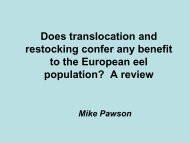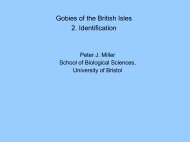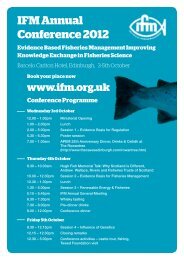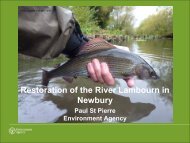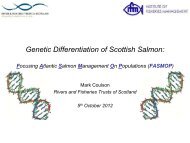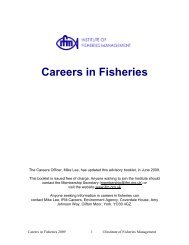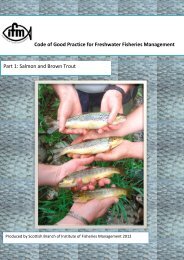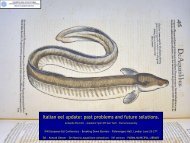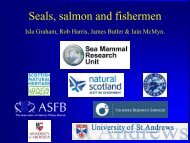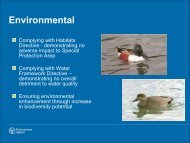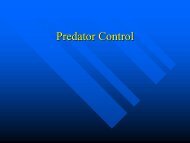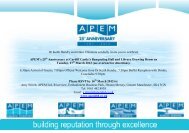Download - Institute of Fisheries Management
Download - Institute of Fisheries Management
Download - Institute of Fisheries Management
Create successful ePaper yourself
Turn your PDF publications into a flip-book with our unique Google optimized e-Paper software.
Fishing for a future- Studies <strong>of</strong><br />
Coregonus autumnalis (Pallas) in Lough<br />
Neagh, Northern Ireland<br />
Warren Campbell<br />
Chris Harrod (QUB) Derek Evans (AFBI)<br />
IFM Rare & Protected Species Conference 28 th March 2012
Lough Neagh<br />
• Large (383 km 2 )<br />
• Shallow (mean depth 8.9 m)<br />
• Highly eutrophic<br />
– Total P ca. 180 µg.l -1<br />
• Long standing fishery (largely eel)<br />
– 350 employed in 2010<br />
– Co-operative owns fishing rights<br />
• Unusual fish community<br />
– Species <strong>of</strong> conservation concern<br />
[coldwater]<br />
• Pollan (Red list- vulnerable)<br />
• River lamprey<br />
• Brown trout<br />
• Eels (Red list- critically endangered)<br />
– Invasive & naturalised species [cool and<br />
warmwater]<br />
• Perch<br />
• Roach<br />
• Bream<br />
• Gudgeon
Pollan (Coregonus autumnalis)<br />
• Salmonid<br />
• Glacial relict species<br />
• Ireland supports only sub-Arctic population<br />
– Known as the Arctic cisco<br />
– Populations in Russia, Canada and Alaska<br />
• Short lived (c.5yrs)<br />
• Rapid growth rate<br />
• Early maturing (2yrs)<br />
– Consequently special case in fisheries management
Conservation value <strong>of</strong> Irish pollan<br />
• IUCN red listed<br />
– “Globally endangered”<br />
• The only European vertebrate found uniquely in<br />
Ireland<br />
– All 5 European populations are Irish<br />
• Lough Neagh described as having the last viable<br />
population (Harrod et al, 2002)<br />
• Irish populations have unique life history<br />
strategy cf. rest <strong>of</strong> the world<br />
– Wholly lacustrine, non-anadromous
Lough Neagh commercial fisheries<br />
• Rights owned by Lough Neagh Fisherman’s<br />
Cooperative Society Ltd.<br />
– Created in 1965<br />
• Perch<br />
– Potential re-emergence with population<br />
recovery, post crash due to overfishing<br />
• Roach and bream<br />
– Low value (31.5p/Kg) incidental fishery<br />
• Pollan<br />
– Medium value (£1.10/Kg)<br />
– Most important fishery during 1 st half <strong>of</strong> 20 th<br />
Century<br />
– Last records kept suggest yield <strong>of</strong> 100-400<br />
tonnes 1893-1914
PhD Aims- “An assessment <strong>of</strong> the fisheries potential<br />
<strong>of</strong> Lough Neagh, Northern Ireland”<br />
1. Characterise the<br />
current status <strong>of</strong> the<br />
fish community <strong>of</strong><br />
Lough Neagh to:<br />
• Develop long-term<br />
monitoring methodology<br />
• Allow science-informed<br />
management<br />
• Investigate current and<br />
future status <strong>of</strong> fisheries<br />
2. Identify alternative<br />
fisheries to that <strong>of</strong> the<br />
declining eel fishery<br />
• Inform diversification to<br />
support rural economy and a<br />
traditional way <strong>of</strong> life
PhD Research questions<br />
• Fish community structure<br />
– What is there? Is it consistent over time?<br />
• <strong>Fisheries</strong> assessment<br />
– What species are being harvested? How much?<br />
– Provision <strong>of</strong> management advice under restricted eel<br />
fishery, climate change<br />
• Development <strong>of</strong> a standardised sampling<br />
methodology for Lough Neagh<br />
• Status <strong>of</strong> key species<br />
– Pollan
Methodology<br />
7 areas sampled every 7weeks<br />
• Gill netting- European CEN<br />
standard multimesh<br />
• Draft netting- encircling <strong>of</strong> fish<br />
with a net <strong>of</strong> known size - a<br />
semi quantitative method<br />
Parameters measured:<br />
• Length & Mass<br />
• Sex- Gonadosomatic Index <strong>of</strong><br />
maturity<br />
• Age & growth-scales<br />
operculae otoliths<br />
• Diet- Gut contents<br />
Lough Neagh sampling sites<br />
BR - Ballyronan Bay<br />
AR – Ardboe<br />
WB – Washing Bay<br />
CR –CranfieldBay<br />
FL – Flats;<br />
BA – Bartins Bay<br />
LM– Lennymore Bay.
What is the current status <strong>of</strong> Lough Neagh<br />
pollan?<br />
Percentage composition<br />
0 20 40 60 80 100<br />
Perch Pollan Eel Brown Trout Roach Gudgeon Bream 3 spined stickleback River lamprey<br />
Species
Population decline?<br />
Comparison <strong>of</strong> draft netting catches<br />
2006 (Inger et al) 2011 (present study)<br />
Species Mean n ha ‐1 + 95% CI Mean biomass<br />
(kg h ‐1 ) + 95% CI<br />
Mean n ha ‐1 + 95% CI<br />
Mean biomass<br />
(kg h ‐1 ) + 95% CI<br />
C. autumnalis 409.7 + 83.1 35.7 + 7.2 78.4 + 21.6 4.52 + 1.8<br />
P. fluviatilis 76.7 + 14.4 2.9 + 0.5 136.7 + 34.3 2.9 + 0.7<br />
R. rutilus 473.4 + 316.9 54.4 + 36.4 3.3 + 2.0 0.1 + 0.1<br />
S. trutta 16.4 + 4.9 4.4 + 1.3 12.8 + 4.0 2.1 + 0.7<br />
G. gobio 13.8 + 4.5 0.2 + 0.1 4.0 + 3.5 0<br />
A. brama 20.8 + 10.9 21.2 + 11.1 1.1 + 1.1 3.9 + 6.2<br />
A. anguilla 127.4 + 23.1 7.6 + 1.4 12.3 + 6 2.2 + 1.1<br />
L. fluviatilis 3.3 + 1.5 0 0.2 + 0.4 0<br />
G. aculeatus 8.8 + 7.8 0 0.6 + 0.7 0<br />
Roach‐Bream<br />
hybrid 1.2 + 1.1 0<br />
0 0<br />
• 81% decline in abundance within 5 years
Population decline?<br />
Fork Length (mm)<br />
50 100 150 200 250 300<br />
1998 1999 2006 2011<br />
Year<br />
Temporal changes in pollan L F<br />
• Pollan L F has declined (median values: 1999 – 231 mm;<br />
2011 – 164mm).<br />
• Cannot rule out overfishing <strong>of</strong> larger pollan.
Development <strong>of</strong> a monitoring programme for Lough<br />
Neagh<br />
Why?<br />
• European CEN standard sampling<br />
protocol using gill nets unsuitable for<br />
Lough Neagh<br />
– Too productive<br />
– Too large<br />
• Draft netting provides a quick estimate<br />
<strong>of</strong> fish abundance, allowing sampling<br />
on a larger scale than with gill nets<br />
• Draft netting requires 1 day <strong>of</strong> suitable<br />
weather conditions, gill netting requires<br />
2 consecutive days<br />
– Can occur infrequently on such a large<br />
water body
Methods for a long term monitoring programme?<br />
Draft and gill net comparisons<br />
• Gill netting effort hampered by weather this season<br />
– Not enough pollan samples to complete comparisons<br />
• Harrod (2001) described no significant difference between pollan length frequency<br />
distributions <strong>of</strong> multi-mesh gill vs draft net captured fish<br />
– However, draft netting captured some small (
Methods for a long term monitoring programme?<br />
Pollan larvae surveys<br />
Pollan larva post-hatching<br />
L T<br />
=10.1mm (2/3/2012)<br />
Pollan larva c. 20 days old<br />
L T<br />
=14.9mm(21/3/2012)<br />
• Pollan are short lived<br />
– Stock size dependant on strength <strong>of</strong> incoming year classes
Methods for a long term monitoring programme?<br />
Pollan larvae surveys<br />
• Towed Icthyoplankton net<br />
– 1.5m x .5m mouth<br />
– 1.5mm mesh size<br />
– 3 tows/site each 1 min<br />
– Flow meter attached, allowing<br />
calculation <strong>of</strong> water volume sampled<br />
and thus larval density<br />
• Completed at 3 known spawning sites<br />
– Weekly, during March/April Lough Neagh pollan larvae sampling sites<br />
BR -Ballyronan Bay<br />
CR – Cranfield Bay<br />
LM– Lennymore Bay.
What is the growth rate <strong>of</strong> pollan larvae in Lough<br />
Neagh?<br />
Length (mm)<br />
8 10 12 14<br />
Density no./m 3<br />
0.5 1.0 1.5 2.0<br />
1 2 3 4<br />
visit<br />
Temporal changes in pollan larvae L T<br />
1 2 3 4<br />
visit<br />
Temporal changes in pollan larvae density<br />
• Hoped to use observed lengths, but mean length is being<br />
suppressed by later hatching larvae<br />
• Observation <strong>of</strong> just hatched larvae during all visits, and unexpected<br />
increases in density with time confirm this<br />
• Daily rings on otoliths instead?
Are there any differences in recruitment<br />
levels between years?<br />
• Early indications suggest<br />
larger larval densities in 2012<br />
than 2011<br />
• Further sampling needed<br />
• Tracking <strong>of</strong> cohorts postrecruitment<br />
0 2 4 6 8 10 12<br />
m3<br />
Density<br />
no./m 3<br />
2011 2012<br />
Year<br />
20 day old pollan larvae densities at Ballyronan
Future status <strong>of</strong> pollan?<br />
• Experiment to examine effects <strong>of</strong> temperature upon<br />
survival to hatching <strong>of</strong> pollan eggs?<br />
– Inform upon climate change effects<br />
– Help describe factors impacting recruitment<br />
• Decline in or restriction upon eel fishing<br />
– Further fishing pressure on pollan<br />
– Decline in illegal fishing <strong>of</strong> 0+ pollan for long line bait?<br />
• More encouraging recruitment figures this year<br />
– Addition <strong>of</strong> a strong year class?
Implications for management so far -1<br />
• Data gained already influencing management<br />
– Discussions with Lough Neagh Fisherman’s Cooperative Society Ltd.,<br />
• Need a proper legislative framework tailored to inland fisheries in NI<br />
– Limits on number <strong>of</strong> licences issued<br />
– Current legal gill net mesh size 44mm<br />
• Unenforced because too large for pollan capture<br />
• Wilson (1973) caught no pollan in 45mm mesh nets<br />
– Simply enforce existing legislation<br />
• 230mm size limit- unenforced
Implications for management so far -2<br />
• Further crack-down on illegal fishing<br />
– Becoming a greater problem with increased<br />
unemployment<br />
• LNFCS needs to take control <strong>of</strong> scale fish fisheries<br />
– Own rights, yet no interest in pollan harvest<br />
– Fish merchants are currently allowed to buy fish<br />
from fishermen<br />
• Fishery anarchy!<br />
• Means that we cannot quantify pollan catch<br />
– Fish could realise a better price = less fish taken for<br />
the same value<br />
• Sold to fish merchant at £1.10/Kg<br />
• Sold as pike deadbait, c. £5.50/Kg<br />
• Uncontrolled fishery- threat<br />
• Sustainably managed fishery- conservation benefit
Pollan- a special case in fisheries<br />
management<br />
• Fluctuating recruitment figures<br />
• Stock size heavily dependant upon<br />
recruitment<br />
• May need a fluid management<br />
strategy, so that fishing effort can<br />
be controlled in relation to year<br />
class strength<br />
• Thankfully now a “hot topic”<br />
– Inland fisheries, including that <strong>of</strong><br />
pollan, were discussed in a<br />
Stormont session (21/2/12)<br />
– Minister stressed need for study<br />
and informed management plans
Acknowledgements<br />
Funding from:<br />
Department for Agriculture and Rural Development.<br />
AFBI NI<br />
Thanks go to:<br />
Dr. Robert Rosell, Eugene O’Kane, Kevin Gallagher, Kenny Bodles, Dr.<br />
Dennis Ensing, Peter Irvine, Sarah McLean, Lough Neagh Fisherman’s<br />
Co-operative Society Ltd.



